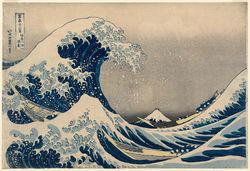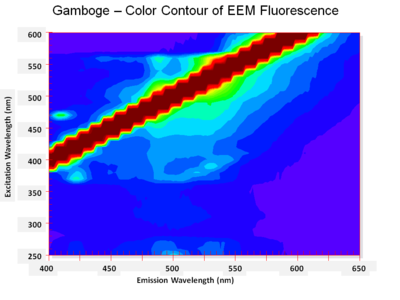Difference between revisions of "Category:Gamboge: Ukiyo-e colorant"
| Line 2: | Line 2: | ||
[[File:SC130566.jpg|right|250px|link=https://collections.mfa.org/objects/234428/under-the-wave-off-kanagawa-kanagawaoki-namiura-also-kn?ctx=ed6b9b8b-e830-4c25-9793-ba7646059146&idx=3|Great Wave by Katsushika Hokusai]] | [[File:SC130566.jpg|right|250px|link=https://collections.mfa.org/objects/234428/under-the-wave-off-kanagawa-kanagawaoki-namiura-also-kn?ctx=ed6b9b8b-e830-4c25-9793-ba7646059146&idx=3|Great Wave by Katsushika Hokusai]] | ||
| − | <font size="3">'''[[Gamboge]]'''</font> | + | <font size="3">'''[[Gamboge]]'''</font> 藤黄(''to-o''): A yellow-orange gum-resin produced by several species of ''Garcinia'' tree found in India, Thailand, Cambodia, Vietnam, and Ceylon. Gamboge was used as a yellow pigment as early as the 8th century in Asia and Japan. It was regularly imported to Europe in the 17th century but a few earlier deliveries may have occurred. Gamboge is composed of a yellow resinous component (70-80%; morelloflavone) and a clear water-soluble [[gum]] (20%). Gamboge is marketed in the form of dull, brownish-yellow cakes or lumps. When powdered, it has a rich golden color. Gamboge is used as a transparent colorant in glazes, varnishes, and watercolors. The carbohydrate gum acts as a natural binder. The yellow color fades when exposed to light or [[ozone]]. In some cases it has recovered its color when placed in the dark. |
For the analysis, it was known that gamboge does not fluoresce in UV light (see below), Thus is was no surprise that gamboge did not produce a distinct pattern using the excitation emission technique. In fact, because it is the only bright yellow colorant that does not fluoresce (of those we have currently analyzed) and because it even absorbs the normal fluorescence given off from the paper, we sometimes used this negative indication to assign the presence of gamboge. | For the analysis, it was known that gamboge does not fluoresce in UV light (see below), Thus is was no surprise that gamboge did not produce a distinct pattern using the excitation emission technique. In fact, because it is the only bright yellow colorant that does not fluoresce (of those we have currently analyzed) and because it even absorbs the normal fluorescence given off from the paper, we sometimes used this negative indication to assign the presence of gamboge. | ||
Revision as of 20:10, 13 May 2020
Gamboge 藤黄(to-o): A yellow-orange gum-resin produced by several species of Garcinia tree found in India, Thailand, Cambodia, Vietnam, and Ceylon. Gamboge was used as a yellow pigment as early as the 8th century in Asia and Japan. It was regularly imported to Europe in the 17th century but a few earlier deliveries may have occurred. Gamboge is composed of a yellow resinous component (70-80%; morelloflavone) and a clear water-soluble Gum (20%). Gamboge is marketed in the form of dull, brownish-yellow cakes or lumps. When powdered, it has a rich golden color. Gamboge is used as a transparent colorant in glazes, varnishes, and watercolors. The carbohydrate gum acts as a natural binder. The yellow color fades when exposed to light or Ozone. In some cases it has recovered its color when placed in the dark.
For the analysis, it was known that gamboge does not fluoresce in UV light (see below), Thus is was no surprise that gamboge did not produce a distinct pattern using the excitation emission technique. In fact, because it is the only bright yellow colorant that does not fluoresce (of those we have currently analyzed) and because it even absorbs the normal fluorescence given off from the paper, we sometimes used this negative indication to assign the presence of gamboge.
For more information see: Gamboge
Examples of Gamboge in Ukiyo-e Prints

|

|

|

|

|
Analysis
Fiber optic reflectance spectroscopy (FORS) can easily identify the three blues: indigo, dayflower, and Prussian blue.
Other Images of Gamboge
List of Prints
List of prints where indigo was detected
Pages in category "Gamboge: Ukiyo-e colorant"
The following 12 pages are in this category, out of 12 total.
G
K
- Kiyomasu I, Courtesan Reading a Poem, 28.198
- Kiyomasu II, Actor Ogino Izaburô I as Yamagami Gennai, Acting in the Aragoto Style with the Sumikazura Wig, 11.13297
- Kiyomasu II, Actors Segawa Kikunojô I as Yomogiu, Ichikawa Ebizô II as Tono no Hyôe, and Yamamoto Kyôzô as Kureha, 21.5459
- Komatsuken, Courtesan Parading with Two Kamuro, 11.19711
- Komatsuken, Young Man as the Bodhisattva Monju, 11.30137
- Komatsuken, Young Woman as the Bodhisattva Fugen, 11.30136







